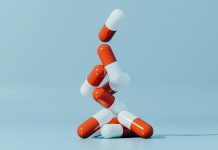
The bipolar disorder sometimes referred to as manic-depressive disorder, is characterized by dramatic shifts in mood, energy, and activity levels that affect a person’s ability to carry out day-to-day tasks.
These shifts in mood and energy levels are more severe than the normal ups and downs that are experienced by everyone.
In a study from Karolinska Institutet, scientists found six predictors that could help determine the amount of lithium needed to treat patients with bipolar disorder.
The study also pinpoints genetic markers that seem to influence how quickly the body eliminates lithium from its system.
Lithium is one of the most important treatments for patients with bipolar disorder, a condition that has been linked to an increased risk of suicide.
The chemical substance works as a mood stabilizer and reduces episodes of depression and mania.
How much is needed varies greatly between individuals and finding the right dose for each patient is key as too much can be toxic while too little is ineffective.
To minimize the risk of side effects, clinicians tend to initiate treatment at low doses that increase over time, meaning it could take months before the treatment has an effect.
To overcome this, researchers have long sought to find a model that could predict dose response in individual patients.
Previous studies have identified markers such as age, sex, and kidney function as possible predictors of how quickly the body eliminates lithium from its system (lithium clearance), which can be used to determine the amount needed on a daily basis.
In the study, the researchers examined data from a total of 2,357 people with bipolar disorder, which may represent the largest sample size for this kind of study to date.
Both men and women ages ranging from 17 to 89 were included, mainly of European ancestry.
The team found associations between the speed of lithium clearance and age, sex, kidney function (measured as eGFR), serum lithium concentrations, and medication with diuretics and substances targeting the renin-angiotensin-aldosterone system (RAAS), which could be used to treat hypertension and other conditions.
The findings suggest that older patients, women, patients with reduced kidney function, and those taking certain medications require lower doses of lithium.
Interestingly, the researchers also discovered that the amount of lithium taken and lithium concentrations in the blood do not seem to be completely proportional, which goes somewhat against current thinking.
The model based on these predictors explained around 50–60% of the variance in lithium clearance, which is better than previous models and could be used to inform treatment decisions.
If you care about brain health, please read studies about new drugs for incurable vascular dementia, and COVID-19 may increase your mental disease risk by 25%.
For more information about brain health, please see recent studies that cataract removal may reduce the dementia risk by 30%, and results showing these antioxidants could help reduce the risk of dementia.
The study was conducted by Martin Schalling et al and published in the journal The Lancet Psychiatry.
Copyright © 2022 Knowridge Science Report. All rights reserved.



